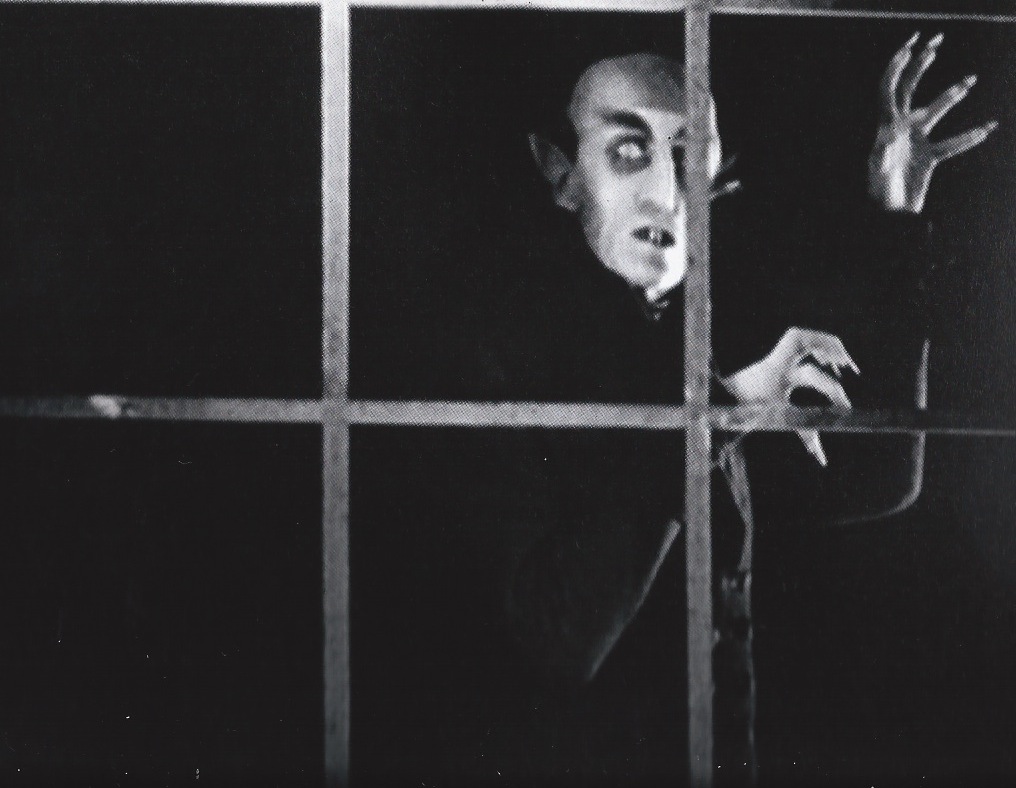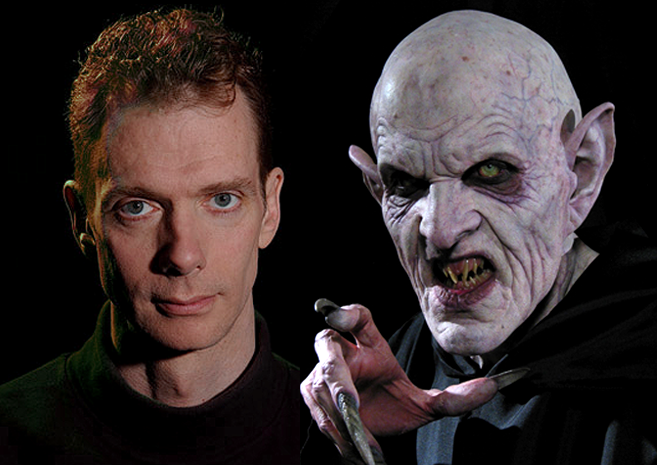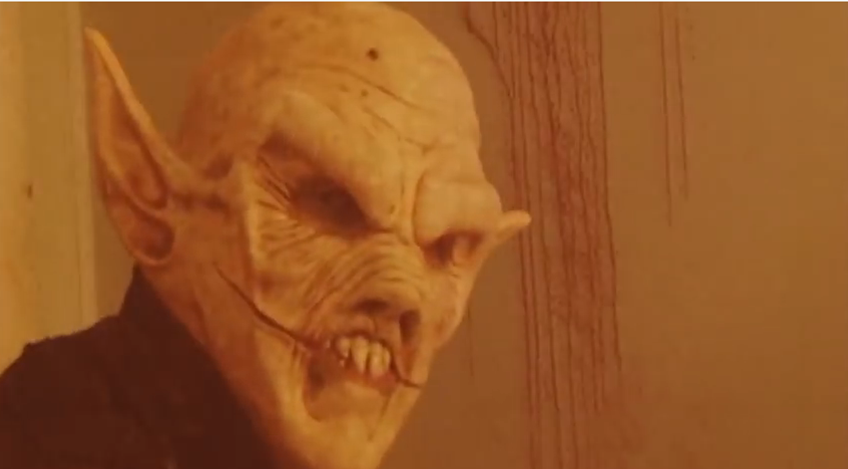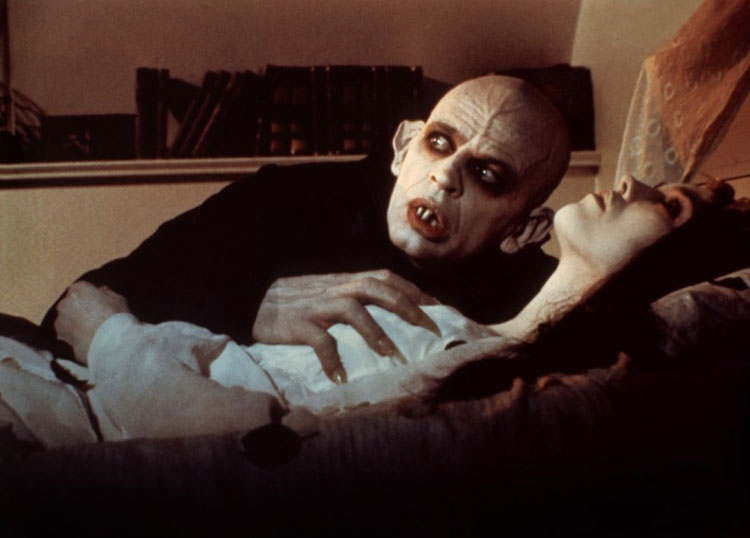
Remaking Nosferatu is not a new idea. As Steve Barton says in his Dread Central article, “Nosferatu Remake in the Works; Doug Jones as Count Orlok” (Nov. 6, 2014): “It amazes me to this very day that there haven’t been more remakes of the much revered and often imitated classic Nosferatu: A Symphony of the Night. The 1921 F.W. Murnau film still holds its own as one of the creepiest vampire tales (loosely based on Bram Stoker’s Dracula) ever put to film.”
Note: though Murnau’s film bears a 1921 copyright date, but was actually released on Mar. 4, 1922, according to Wikipedia. Barton adds: “In 1979 Werner Herzog tried his hand at making a remake with Nosferatu the Vampyre, starring Klaus Kinski as the fiendish Count Orlok, with mixed results; and we think it’s high time someone brings the Count back in all of his ratlike glory. The man for the job… there’s no doubt about it… is Doug Jones (Pan’s Labyrinth, Hellboy, ‘Falling Skies’).”

There was another remake Barton overlooked: a “blood-drenched revisioning” by David R Williams called Red Scream Nosferatu (2009). Andy Boylan says the film was made by someone “brave or foolish” in his Sept. 25, 2010 review, and chooses the latter option: “Noodling where it didn’t need noodling and struggling due to lack of budget and locations,” he wrote before adding: “Cruel as I am in my conclusions; this touched, perhaps even violated, a classic piece of cinema and most of the touches were the fumbling of a clumsy virgin, only in the one mentioned section did the virgin become Casanova.”

Williams’ filmmaking methods were vampiric in their own right. As New York Post article “Vampire Flick Producer Jailed for NY Embezzlement” (June 7, 2010) reveals, Williams was “sentenced to six months in jail for embezzling $265,000 from his employer to finance micro-budget vampire movies” which included Red Scream Nosferatu.
The report adds: “David Williams acknowledged in court that he stole the money between February 2006 and July 2009 by misusing company credit cards belonging to VWR International, a scientific equipment maker he worked for in the Buffalo suburb of Tonawanda.” That makes this film Williams’ second biggest crime.
The “remake” tag is something filmmakers seem keen to avoid. Werner Herzog doesn’t even believe his own version is a remake. Regarding the 1979 film’s May 22, 2014 re-release at Los Angeles’ Cinefamily, Mark Olsen drives the point home in his L.A. Times article “Re-release of Werner Herzog’s ‘Nosferatu’: ‘It’s not a remake’” (May 16, 2014), opening with a quote from Herzog: “I should caution you, it’s not a remake.” Olsen elaborates: “Rather consider it an interpretation or tribute.”

We see the same wariness of using the poisonous “remake” tag even in the Nosferatu “revisioning”, Red Scream Nosferatu. Similarly, Fisher dubs his own film, a Kickstarter project: “Nosferatu — The Feature Film Remix.” As of this writing, it has 273 backers and $31,621 in pledges, with 12 days to go before deadline. Will it reach its target? The real question is: should it?
The project’s biggest drawcard is Doug Jones, a talented actor in the Andy Serkis vein, most recognisable when slathered in make-up and CGI effects: you may know him from his roles as zombie Billy Butcherson in Hocus Pocus (1993), Abe Sapien in Hellboy (2004) and Fauno and Pale Man in Pan’s Labyrinth (2006). He doesn’t need the work: he’s got several films in pre-production through to 2015.
This is Fisher’s Kickstarter pitch: “By combining imagery from the original horror classic with cutting edge filmmaking technology, we will resurrect the screen’s first and most monstrous vampire back from the grave!” And: “OUR GOAL is to produce a feature-length, faithful homage to this classic masterpiece through use of an updated story structure, plot pacing, visual effects, and importantly sound and music. We believe this ‘fresh take on an old tale’ will bring something new to devoted fans, and excite an entire new generation of audiences as well.”
How does Fisher propose to reach that goal? What’s fresh about his take? His Kickstarter page reveals he will be employing a method he calls a “visual remix,” a technique he employed in his previous attempt at remaking a German Expressionist era film, The Cabinet of Dr. Caligari (2005), which starred Jones as Cesare. This process involves “scanning a vintage print” which means he can then “shoot our actors on green-screen, then layer them into digital sets recreated from the original film’s imagery.”

As dazzling as that technique may be, why bother? There’s a much more logical solution for people wanting to see a reproduction of the original: watch the original. It’s freely available online and doesn’t cost a cent to view. Also, a shot-for-shot “update” of a classic horror film’s already been done: Gus Van Sant’s critically-panned Psycho (1998). Robert Ebert had this to say about Van Sant’s remake in his Chicago Sun-Times review (Dec. 6, 1998): “The most dramatic difference between Alfred Hitchcock’s ‘Psycho’ (1960) and Gus Van Sant’s ‘shot-by-shot’ remake is the addition of a masturbation scene. That’s appropriate, because this new ‘Psycho’ evokes the real thing in an attempt to re-create remembered passion.”
Ebert added: “Curious, how similar the new version is, and how different. If you have seen Hitchcock’s film, you already know the characters, the dialogue, the camera angles, the surprises. All that is missing is the tension–the conviction that something urgent is happening on the screen at this very moment. The movie is an invaluable experiment in the theory of cinema, because it demonstrates that a shot-by-shot remake is pointless; genius apparently resides between or beneath the shots, or in chemistry that cannot be timed or counted.”
Fisher’s proposed film has a similar burden on its shoulders. After all, there’s more to Marnau’s film than flashy camera techniques. As Matthew Sheldon notes in his Classic Art Films assessment of Marnau’s masterpiece (July 23, 2012): “There are no cheap or sudden scares in the film and instead what truly frightens us are its creepy images, its hypnotic mood and its tortured creature, who has to live through a dreaded and horrific curse.”
By contrast, Fisher’s asking $60,000 to create a pseudo-reproduction of the original film. Don’t get me wrong: I think Fisher’s “visual remix” concept has lots of potential for making “period” films in the same way sepia Instagram filters make modern photos look “old”, but why apply the technique to a film that already exists and sufficiently demonstrates age and innovation already? Does it need dialogue outside its intertitles? Does it need an updated “story structure”?
Ninety-two years have passed since Marnau’s film was released. If it can’t be “improved” without resorting to duplicating the original, despite all our cinematic innovations and ready access to editing software, one must seriously ask: what’s the point? Herzog’s “it’s not a remake” remake at least made the effort to bring something new to the table by tweaking the original’s story into a 19th century Apocalypse.
Herzog’s film also embraced another significant innovation developed between the decades following Murnau’s original: colour film. The same innovation was used in E. Elias Merhige’s Shadow of the Vampire (2000) which featured its own novel twist on Murnau’s film: what if the original’s star, Max Schreck (1879–1936), really was a vampire?
And Fisher’s contribution to the Nosferatu cinematic canon? Basically repeating the same story and recapturing the original film’s “look.” Is that “innovation” worth $60,000?
If you’re interested in funding David Fisher’s Kickstarter project, “Nosferatu — The Feature Film Remix,” click here. I also challenged Erin to watch the original movie through “virgin eyes,” as she’d never seen it before. Here’s what she thought about it. I followed her review up with my own assessment, which also discussed the rationale behind my “experiment.”
I was inspired to write this article after participating on Camila Craig’s “Nosferatu, one of my favs” thread on the Count Dracula Facebook group.
1 comment
Comments are closed.